skip to main |
skip to sidebar
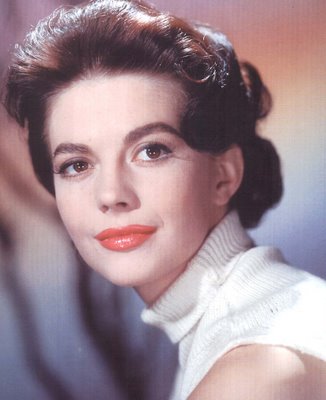 Monday Glamour Starter --- Natalie Wood --- Part 2I didn’t say much about Natalie Wood’s movies in Part 1, wanting to save that for today’s entry. I subscribe to the radical notion that Nat’s best work isn’t Splendor In The Grass, or West Side Story, or any of those other ponderous sixties things. I've always preferred her in Warner cheeseburgers like The Girl He Left Behind (a classic), Bombers B-52 (you shouldn’t have turned it down, Tab!), Marjorie Morningstar (her debut as a "serious" actress), and Cash McCall (it will live forever). These were the ones made to order for the Natalie clubs and their fifteen- year-old girl memberships who’d mimicked her gamine haircut and breathlessly awaited news of the next "romance" (would Tab be supplanted by Ray Burr?). Sitting through these pics today (if you can find them --- ain’t easy) is a time transport back to a day when fan culture and movie production still walked hand-in-hand. It wouldn’t last much longer…
Monday Glamour Starter --- Natalie Wood --- Part 2I didn’t say much about Natalie Wood’s movies in Part 1, wanting to save that for today’s entry. I subscribe to the radical notion that Nat’s best work isn’t Splendor In The Grass, or West Side Story, or any of those other ponderous sixties things. I've always preferred her in Warner cheeseburgers like The Girl He Left Behind (a classic), Bombers B-52 (you shouldn’t have turned it down, Tab!), Marjorie Morningstar (her debut as a "serious" actress), and Cash McCall (it will live forever). These were the ones made to order for the Natalie clubs and their fifteen- year-old girl memberships who’d mimicked her gamine haircut and breathlessly awaited news of the next "romance" (would Tab be supplanted by Ray Burr?). Sitting through these pics today (if you can find them --- ain’t easy) is a time transport back to a day when fan culture and movie production still walked hand-in-hand. It wouldn’t last much longer…

Of course, Natalie was a seasoned vet when she made the big teen splash with Rebel Without A Cause. Her moppet resume seems to have jinxed her in the eyes of director Nick Ray, who wanted a fresh face for her role. Upstart cast members were suspicious of her "Old Hollywood" links (she’d worked with Bing Crosby after all), so she had to overcome a degree of prejudice there. This first grouping shows Nat with her cigarette poised over what appears to be a waste can full of discarded film strips (good thing they’d made the transition to safety film by this time!). Is that a reefer behind Jimmy Dean’s ear? Kinda looks like one. He’s checking out today’s call sheet. Let’s see, are there any seasoned character actors who can prop me up and make my self-conscious performing look good, like Albert Dekker, Raymond Massey, and the others did in East Of Eden? Nick Adams is quietly speculating as to whether director Ray might let him wear that silly hat on screen --- Nick’ll do most anything for attention, you know.
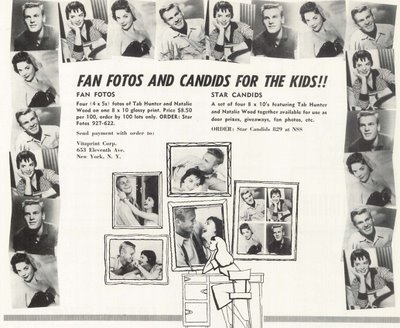
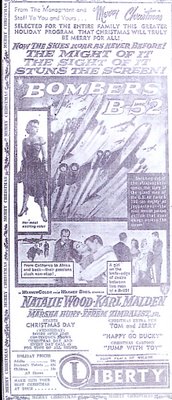 Natalie drops in on Warner Brothers Presents host Gig Young at the "location" for The Searchers as they pose before one of the most audacious process screens ever to stand in for an outdoor setting. Natalie speaks to the home viewers as though she were giving the valedictorian address at Hollywood High School. These "behind-the-scenes" moments were forced on ABC by Warners as part of the deal when that studio finally agreed to dip its corporate toes into video waters. The program collapsed in the first season. The photo offering we next see was part of the campaign for The Girl He Left Behind, a peacetime service romance in which Natalie and Tab Hunter were teamed for the first time. Selling fan photos in bulk meant exhibitors could hand them out to patrons coming in, or use them as giveaways with radio dee-jays, record stores, and the like. Director David Butler later confessed that he’d have preferred young supporting player James Garner for the lead instead of Hunter, but the big guns were behind Tab after Battle Cry, so Garner was vetoed by studio brass. Butler also recalled Natalie having to take breaks for school "lessons" and avoid exhaustion (still a minor, you see). Trouble is, as soon as work was finished, she’d be off for all-night partying, and come in the next day --- exhausted. Must have been an excess of ice-cream sodas, as we’re assured by the fan mags that Natalie was a model teen.
Natalie drops in on Warner Brothers Presents host Gig Young at the "location" for The Searchers as they pose before one of the most audacious process screens ever to stand in for an outdoor setting. Natalie speaks to the home viewers as though she were giving the valedictorian address at Hollywood High School. These "behind-the-scenes" moments were forced on ABC by Warners as part of the deal when that studio finally agreed to dip its corporate toes into video waters. The program collapsed in the first season. The photo offering we next see was part of the campaign for The Girl He Left Behind, a peacetime service romance in which Natalie and Tab Hunter were teamed for the first time. Selling fan photos in bulk meant exhibitors could hand them out to patrons coming in, or use them as giveaways with radio dee-jays, record stores, and the like. Director David Butler later confessed that he’d have preferred young supporting player James Garner for the lead instead of Hunter, but the big guns were behind Tab after Battle Cry, so Garner was vetoed by studio brass. Butler also recalled Natalie having to take breaks for school "lessons" and avoid exhaustion (still a minor, you see). Trouble is, as soon as work was finished, she’d be off for all-night partying, and come in the next day --- exhausted. Must have been an excess of ice-cream sodas, as we’re assured by the fan mags that Natalie was a model teen.
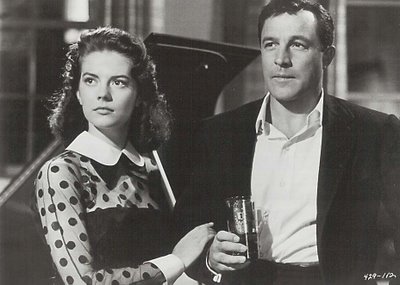
Impetuous Tab went on suspension to avoid Bombers B-52 and a new star was born, Efrem Zimbalist, Jr., who also got the TV part Hunter nixed --- Stu Bailey in 77 Sunset Strip (colossal boner there, Tab). The fact such pictures once got respect is borne out by this Christmas 1957 ad from our own Liberty Theatre, where Bombers B-52 was the brightest ornament on the holiday program. These Warner pics stayed within limited budgets --- The Girl He Left Behind had a negative cost of $967,000 --- Bombers B-52 cost $1.4 million. Domestic rentals were fairly predictable --- Girl took $1.3 million, and Bombers less at $1.1 (probably because Hunter didn’t do it). Bigger things were expected for Marjorie Morningstar, which they hoped would break beyond Natalie’s (age) limited fan base, but that expensive production ($2.8 million negative) took a loss of $190,000. Part of the problem may have been the eccentric romantic pairing of Natalie with Gene Kelly (playing a character 32 when he was 46). Her jump to major stardom came with loan-outs, but she'd had to compete with mainstream actresses more accomplished in the dramatic stuff she longed to do. By then, the Natalie Wood teenage fan phenomenon had run its course, and the bloom was off the rose. We’re sure there’s no urgency on Warner’s part to release Natalie’s early features on DVD, but we’d love to see them again all the same. Any votes out there for a box set?
Finally, we'd like to acknowledge (and enthusiastically recommend!) a fantastic Natalie Wood website, which you can find HERE. It's filled with articles, photos, essays ... the ultimate go-to place for all things Natalie. So, go there and be dazzled!

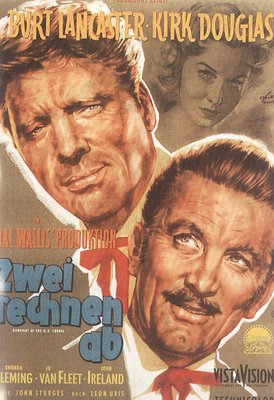
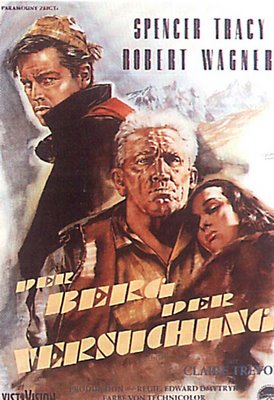

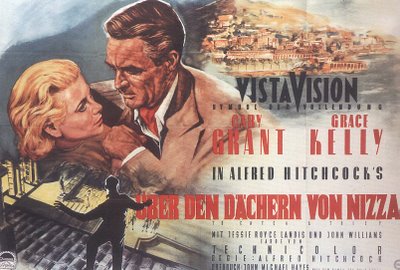 They Act Their Age In GermanyAs this writer gets older, he appreciates more and more those who are willing to act their age. He appreciates even more those poster artists willing to depict actors as they really are, or in this case, were. These images aren’t designed to flatter their subjects. There’s an honesty about them that’s refreshing. We never had posters in the U.S. so revealing of their subjects as these. I think they’re great. You really get the character of these veterans as they headed into the twilight of their careers. Apparently, German audiences were better prepared to appreciate these actors in realistic terms, while the rest of us made do with heavily retouched, misleading portrayals. That’s a wonderful image of Spencer Tracy, for instance. It’s from The Mountain, and sure enough, that’s how Spence looked by 1956 --- like a monument. This artist salutes those long, hard years that brought Tracy here. To my mind, he never looked so majestic. Same for Bogart. The artist doesn’t shrink from the dissipation that shows in the man’s expression. In fact, he celebrates it. As far as I’m concerned, none of Bogart’s American posters convey his stature so effectively. Burt Lancaster and Kirk Douglas were not so old, of course, but already the artist explores the mature image that is making it’s presence felt in their screen images, and celebrates it. Cary Grant may not have appreciated the rather severe depiction we have here, but isn’t it refreshing to have a glimpse of the actor at a point when age was becoming a serious issue, and Grant was himself considering retirement at times because of it. There’s such drama in these German posters. They seem to have understood these icons far better than we ever did.
They Act Their Age In GermanyAs this writer gets older, he appreciates more and more those who are willing to act their age. He appreciates even more those poster artists willing to depict actors as they really are, or in this case, were. These images aren’t designed to flatter their subjects. There’s an honesty about them that’s refreshing. We never had posters in the U.S. so revealing of their subjects as these. I think they’re great. You really get the character of these veterans as they headed into the twilight of their careers. Apparently, German audiences were better prepared to appreciate these actors in realistic terms, while the rest of us made do with heavily retouched, misleading portrayals. That’s a wonderful image of Spencer Tracy, for instance. It’s from The Mountain, and sure enough, that’s how Spence looked by 1956 --- like a monument. This artist salutes those long, hard years that brought Tracy here. To my mind, he never looked so majestic. Same for Bogart. The artist doesn’t shrink from the dissipation that shows in the man’s expression. In fact, he celebrates it. As far as I’m concerned, none of Bogart’s American posters convey his stature so effectively. Burt Lancaster and Kirk Douglas were not so old, of course, but already the artist explores the mature image that is making it’s presence felt in their screen images, and celebrates it. Cary Grant may not have appreciated the rather severe depiction we have here, but isn’t it refreshing to have a glimpse of the actor at a point when age was becoming a serious issue, and Grant was himself considering retirement at times because of it. There’s such drama in these German posters. They seem to have understood these icons far better than we ever did.
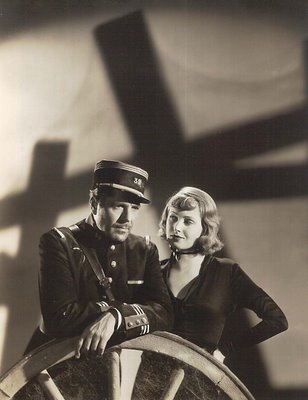
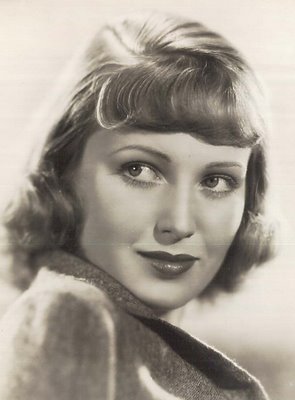
 Reader Request --- June LangOccasionally we get requests, usually for more of a star we’ve just highlighted, but correspondent "Chris" e-mailed the other day with an interesting suggestion that sent us digging into the file cabinets --- he’d just seen The Road To Glory, a 1936 Fox war drama directed by Howard Hawks, and was mightily impressed by June Lang, an actress whose sexuality, he said, "dripped off the screen." Since we’d been at least ten years since seeing the movie, it seemed like a good time to take another look. Sure enough, there’s June Lang, and yes, you’ll need a grease pan, or a bucket, or whatever’s handy to mop up all that dripping sexuality. June’s all the more impressive for putting it over in a Code show, and she’s a big reason we’d recommend The Road To Glory (which has turned up from time-to-time on Fox Movie Channel). She was a busy actress in the thirties, and worked with Shirley Temple (Wee Willie Winkie), Laurel and Hardy (Bonnie Scotland), and other big names. Her career got sidetracked by an ill advised marriage to well-known mobster Johnny Roselli. She only died within the past year. Does anyone know if she was ever interviewed? Seems I heard somewhere that she was pretty inaccessible. Chris couldn’t locate much June Lang on a web image search, so he asked us to fill the breech. To quote Art Baker then, You Asked For It.
Reader Request --- June LangOccasionally we get requests, usually for more of a star we’ve just highlighted, but correspondent "Chris" e-mailed the other day with an interesting suggestion that sent us digging into the file cabinets --- he’d just seen The Road To Glory, a 1936 Fox war drama directed by Howard Hawks, and was mightily impressed by June Lang, an actress whose sexuality, he said, "dripped off the screen." Since we’d been at least ten years since seeing the movie, it seemed like a good time to take another look. Sure enough, there’s June Lang, and yes, you’ll need a grease pan, or a bucket, or whatever’s handy to mop up all that dripping sexuality. June’s all the more impressive for putting it over in a Code show, and she’s a big reason we’d recommend The Road To Glory (which has turned up from time-to-time on Fox Movie Channel). She was a busy actress in the thirties, and worked with Shirley Temple (Wee Willie Winkie), Laurel and Hardy (Bonnie Scotland), and other big names. Her career got sidetracked by an ill advised marriage to well-known mobster Johnny Roselli. She only died within the past year. Does anyone know if she was ever interviewed? Seems I heard somewhere that she was pretty inaccessible. Chris couldn’t locate much June Lang on a web image search, so he asked us to fill the breech. To quote Art Baker then, You Asked For It.
Imagining The Life Of Bill WolfeEver been so frustrated by the lack of information on a favorite personality that you’d resort to inventing your own biography for him/her? Well, today’s little bit of April Foolery is Greenbriar's imagining of the life of Bill Wolfe, that stalwart stooge who enlivened a number of W.C.Fields comedies with his ultra-low-key, cadaverous presence. I’d like to think Bill enjoyed an exciting and romantic life off-screen --- why should his admittedly skeletal, undernourished appearance deprive him of Hollywood’s high life? Whatever wrongs were done to Bill by way of neglect or indifference (try finding any info on this poor guy!), we are here to right them in the Greenbriar Theatre Of The Imagination --- so here goes with some memorable moments from the life Bill Wolfe should have had ---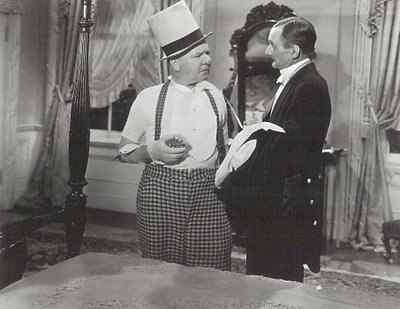
 Bill agrees to fill in for pal Jack Barrymore when the "Hamlet" star twists an ankle backstage. It’s just one performance, but the audience was still talking about it months later when harried producers made a bid to replace Barrymore with Wolfe. "Can’t do that to a friend", says Bill, but still-in-a-pique Barrymore refuses to speak to him for the next ten years.
Bill agrees to fill in for pal Jack Barrymore when the "Hamlet" star twists an ankle backstage. It’s just one performance, but the audience was still talking about it months later when harried producers made a bid to replace Barrymore with Wolfe. "Can’t do that to a friend", says Bill, but still-in-a-pique Barrymore refuses to speak to him for the next ten years.
Teenage Follies showgirl Louise Brooks embarrasses Bill when she refuses to vacate his digs at the St. Regis after a night of intense lovemaking. Decades later, her explicit recollections of the event are judiciously edited from an otherwise revealing PBS documentary.
Bill graciously volunteers to take over crowd control at the Valentino funeral in 1926. After all, he’d once rescued Rudy from a gigolo’s fate by getting him some extra work on Long Island. Trouble is, once Bill gets out among the mob in front of Campbell’s Mortuary, frenzied femmes get one look at him and forget all about Rudy! Pulled down from his mount, Good Samaritan Bill has to be rescued by cops.
Arriving in Hollywood, Bill begs old friend Joe Schenck not to sell Buster Keaton’s contract to Metro. Then he implores Buster not to go along, but the advice goes unheeded. Years later, Joe admits he was wrong when loyal Bill accompanies him to the train headed for federal prison. Seems poor Joe had also ignored Bill’s recommendation that he pay those income taxes!
When Doug Fairbanks chickens out on a hazardous Iron Mask stunt, Bill pinch hits for him and leaves premiere audiences aghast. "Let’s not say anymore about it" is modest Bill’s only statement for a curious fan mag columnist.
Some busy body at the Coconut Grove tells Bill that cowboy star Ken Maynard’s being cruel to his horse, Tarzan, over at Universal. In a rare show of temper, Bill strides over to Ken’s table and gives him a good pasting right then and there. Next day, it’s all handshakes and forgiveness. "Guy’s got a right hook like a jackhammer!" admits Ken, as he gives Tarzan some extra sugar cubes under Bill’s watchful eye.
Bill takes up for one-time boyhood chum John Gilbert when he rebuffs Irving Thalberg’s plea that he replace Jack in the Red Dust lead. Seems Irving thought Bill would be perfect to star opposite up and coming bombshell Jean Harlow. Discussion of the matter doesn’t go beyond Thalberg’s office. "After all", says Bill, "hasn’t Jack had enough disappointment?" Several years later, eventual Red Dust star Clark Gable sees Bill at the Troc. "Thanks for the break", he murmurs, as they pass each other at the bar. "Don’t know what you’re talking about, Clark", replies a subdued Bill.
Seeking to assist family friend and former Broadway juve Humphrey Bogart (Bill had once co-authored a medical journal piece with Bogie’s physician dad), Wolfe advises thuggish dumbbell actor George Raft not to accept the leads in High Sierra and The Maltese Falcon. When he’s reminded of it years later, Bill gets a belated attack of guilt and arranges for buddy Frank Sinatra to throw down-and-out George a couple days work on Ocean’s 11.

Patriotic Bill is forfeiting a night at the clubs to put in a volunteer stint dishwashing at the Hollywood Canteen when he hears a ruckus in the parking lot. Seems a bunch of Marines are getting fresh with starlet-hostess Yvonne De Carlo, so good-guy Bill lends a hand by taking on the whole battalion! Within minutes, the ground’s fairly littered with chastened leathernecks. "Let’s remember we’re gentlemen, boys", he tells the penitent warriors, "… besides, we’d all rather see you whip Hitler than an old duffer like me". Reporters were amused when they noticed Yvonne’s enthusiastic attentions toward her shining knight. "I’m stuck to Bill like glue!" said she as a scarlet-faced Wolfe rushed back to his dishes!
Bill’s own induction was delayed by what he referred to as a "military snafu", but insiders knew that the old rascal had lied about his age. Long-time padre (and navy Admiral) "Bull" Halsey finally gave Wolfe his own vessel, but how could he have anticipated that Bill would sail the thing right into Tokyo Bay --- and in the week before the surrender!
Delores catches Bob dead-to-rights in Marilyn Maxwell’s apartment, and it’s the night before he’s supposed to host the 1951 Oscars! Soft-touch Bill agrees to step in, but Bob’s let out of the doghouse just before the curtain. The two old friends share a laugh about the whole thing at Musso and Frank’s the next day. Twenty years later, loyal Bill stakes Marilyn’s love-child to a Harvard education. "I don’t care if it’s Bob’s or mine. Every kid deserves a leg up!"

 Fleischer Challenges DisneyA lot of viewers regard Max Fleischer Color Classics as the poor man’s Silly Symphonies. Paramount tried to sell their cartoon man as a possible successor to Disney’s throne, but one look at a few of these shorts, and you knew it wasn’t gonna happen. Max was great with Popeye and Betty Boop, and I’d challenge Walt to have done them better, but these Color Classics are all too clearly poaching on Disney’s Technicolor-ed preserves, and they generally come up wanting. To start with, Paramount couldn’t even use the three-color process. Disney had that locked up with an exclusive pact he’d made with Technicolor's people in 1932 when he launched his first color Symphony, Flowers and Trees. The deal was, nobody makes full-blooded Technicolor cartoons except Disney, and because of that edict, Fleischer had to go begging with whatever ragtag processes he could harness --- first Cinecolor (red and green only --- try topping Disney with that) and later Technicolor’s own, and very limited, two-color process, which by its name implied a limited palette. This might not be so bad given the original elements for proper DVD restoration. As it is, virtually all Fleischer's Color Classics long ago fell into the Public Domain, and now it's catch-and-catch-can for anyone wanting to gather them up for a re-viewing. As it happens, a team of dedicated animation archeologists, led by eminent cartoon historian Jerry Beck, have done just that --- unearthing the best available elements on these shorts and releasing same in a two-pack DVD that finally allows us to screen these rarities end to end. Having stumbled upon Paramount exhibitor manual ads this weekend for a visual aid, I decided to give the cartoons a look.
Fleischer Challenges DisneyA lot of viewers regard Max Fleischer Color Classics as the poor man’s Silly Symphonies. Paramount tried to sell their cartoon man as a possible successor to Disney’s throne, but one look at a few of these shorts, and you knew it wasn’t gonna happen. Max was great with Popeye and Betty Boop, and I’d challenge Walt to have done them better, but these Color Classics are all too clearly poaching on Disney’s Technicolor-ed preserves, and they generally come up wanting. To start with, Paramount couldn’t even use the three-color process. Disney had that locked up with an exclusive pact he’d made with Technicolor's people in 1932 when he launched his first color Symphony, Flowers and Trees. The deal was, nobody makes full-blooded Technicolor cartoons except Disney, and because of that edict, Fleischer had to go begging with whatever ragtag processes he could harness --- first Cinecolor (red and green only --- try topping Disney with that) and later Technicolor’s own, and very limited, two-color process, which by its name implied a limited palette. This might not be so bad given the original elements for proper DVD restoration. As it is, virtually all Fleischer's Color Classics long ago fell into the Public Domain, and now it's catch-and-catch-can for anyone wanting to gather them up for a re-viewing. As it happens, a team of dedicated animation archeologists, led by eminent cartoon historian Jerry Beck, have done just that --- unearthing the best available elements on these shorts and releasing same in a two-pack DVD that finally allows us to screen these rarities end to end. Having stumbled upon Paramount exhibitor manual ads this weekend for a visual aid, I decided to give the cartoons a look.

 First of all, does anyone remember seeing these on TV back in syndication years? I actually do not. None crossed my path until I began collecting 16mm, and then were often as not black and white prints of indifferent quality and condition. I know N.T.A. (National Telefilm Association) distributed these for television, but none of our stations used them, and if they had, I dare say we'd have seen B/W prints (all our syndicated WB cartoons were that way until the late 60’s). When I finally scored a color Fleischer around 1980 (Christmas Comes But Once A Year), I thought it was interesting, but a little long, and not a patch on what Disney was doing around the same time (mid-thirties). All the Color Classics tend toward long, and in direct comparison with Silly Symphonies (I went back-and-forth between them a few times), they don’t really stand a chance. To be fair, we have to consider prints used for both (check out DVD frames shown here --- one from Fleischer’s Somewhere In Dreamland, the other from Disney’s Music Land). Disney has original elements, with their presentation impeccable. VCI (the Color Classic distributor) had, for the most part, 16mm prints gathered from collectors, rental houses, and archives around the world, a salvage operation necessitated by fact of the cartoon’s present owners' unwillingness to restore and release their property. VCI has done remarkably well all the same, and I'd certainly recommend their set. These Color Classics are said to have come back into the possession of Paramount after some fifty years of wandering between (ownership) winds. That’s good and bad, of course. Good for their having returned to the home lot, bad because Paramount has so far shown no interest in cartoons on DVD. Speaking of DVD cartoon collections, I’d cast a "yes" ballot for more audio commentaries like ones on the Color Classics set. Having listened to several, as well as ones on the Looney Tune collections, I’m struck by joyful and unabashed enthusiasm these experts bring to their narrations. They love cartoons, and their flights of rapture over Daffy, Porky, and the rest have done much to enhance my enjoyment of these shorts. It goes without saying I’m overwhelmed by the depths of their knowledge in that field, but best of all is fact they have such fun with cartoons, and it’s infectious.
First of all, does anyone remember seeing these on TV back in syndication years? I actually do not. None crossed my path until I began collecting 16mm, and then were often as not black and white prints of indifferent quality and condition. I know N.T.A. (National Telefilm Association) distributed these for television, but none of our stations used them, and if they had, I dare say we'd have seen B/W prints (all our syndicated WB cartoons were that way until the late 60’s). When I finally scored a color Fleischer around 1980 (Christmas Comes But Once A Year), I thought it was interesting, but a little long, and not a patch on what Disney was doing around the same time (mid-thirties). All the Color Classics tend toward long, and in direct comparison with Silly Symphonies (I went back-and-forth between them a few times), they don’t really stand a chance. To be fair, we have to consider prints used for both (check out DVD frames shown here --- one from Fleischer’s Somewhere In Dreamland, the other from Disney’s Music Land). Disney has original elements, with their presentation impeccable. VCI (the Color Classic distributor) had, for the most part, 16mm prints gathered from collectors, rental houses, and archives around the world, a salvage operation necessitated by fact of the cartoon’s present owners' unwillingness to restore and release their property. VCI has done remarkably well all the same, and I'd certainly recommend their set. These Color Classics are said to have come back into the possession of Paramount after some fifty years of wandering between (ownership) winds. That’s good and bad, of course. Good for their having returned to the home lot, bad because Paramount has so far shown no interest in cartoons on DVD. Speaking of DVD cartoon collections, I’d cast a "yes" ballot for more audio commentaries like ones on the Color Classics set. Having listened to several, as well as ones on the Looney Tune collections, I’m struck by joyful and unabashed enthusiasm these experts bring to their narrations. They love cartoons, and their flights of rapture over Daffy, Porky, and the rest have done much to enhance my enjoyment of these shorts. It goes without saying I’m overwhelmed by the depths of their knowledge in that field, but best of all is fact they have such fun with cartoons, and it’s infectious.

These colorful ads for the Fleischer group were included in some of those lavish Paramount sales manuals designed to induce exhibitors to sign on with the studio’s season package. Much was at stake here, as individual contracts meant a showman’s commitment to run most of the studio’s output over the course of that year, so Paramount always put its best foot forward in these promotionals. I was lucky enough to come into possession of several account books which once belonged to a Paramount customer during 1937-38. This was a rural North Carolina exhibitor with a small house and no doubt smaller audiences, but he booked heavily with that company, as well as United Artists and RKO. These last two handled Disney product, and in fact, Walt’s transition from UA to RKO for distribution of his cartoons took place around this time. These ledgers are a treasure trove for me, as they show just how much this exhibitor spent in rentals at that time, as well as offering a comparison between cartoon prices for Paramount and Disney. For instance, a Silly Symphony through UA, Woodland Café, was $5.00 flat, while a later Donald Duck (Self-Control) through RKO got $5.25. Paramount took only $2.00 for a December 1937 booking of Christmas Comes But Once A Year, but that Fleischer Color Classic was by then an oldie, having come out the previous December, so terms were a little more favorable for this run. Otherwise, this theatre doesn't appear to have used the Color Classics, although they did book heavily on the Popeyes (I Like Babies and Infinks cost $4.86). The best money for cartoons from this venue seems to have been collected by MGM, whose Bosko and The Pirates got $6.65, while Bosko’s subsequent encounter with the Cannibals netted $6.95 for the Metro exchange. Just a lot of numbers for long-ago, and long forgotten, bookings --- but they give us some insight into the selling end of the cartoon business, at a time when such nickels-and-dimes as these kept small showmen, and big studios, afloat.
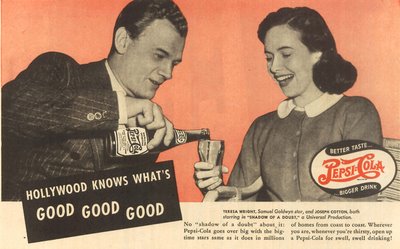
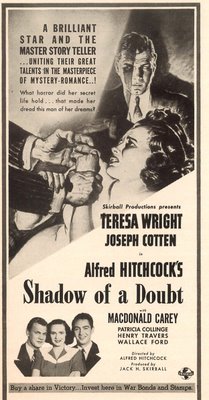 Shadow Of A Doubt OdditiesWho says the world is a foul sty? Uncle Charlie’s been ripping the fronts off houses, and what did he find? Not swine, but a refreshing Pepsi Cola, which he shares here with an admiring Young Charlie. Since they’re mirror images anyway, and share all the guilt over those Merry Widow murders (not forgetting that unspoken, beneath-the-surface incestuous attraction the Hitchcock books talk about), it’s a cinch they’d both have a taste for that bracing cola flavor, particularly after an exhausting day pushing each other around a mock-up train and falling into process screens. What’s a serial killer to do when he can’t charm his niece with rings taken off the corpses of his latest victims? He just says Pepsi, Please! and all’s forgiven.
Shadow Of A Doubt OdditiesWho says the world is a foul sty? Uncle Charlie’s been ripping the fronts off houses, and what did he find? Not swine, but a refreshing Pepsi Cola, which he shares here with an admiring Young Charlie. Since they’re mirror images anyway, and share all the guilt over those Merry Widow murders (not forgetting that unspoken, beneath-the-surface incestuous attraction the Hitchcock books talk about), it’s a cinch they’d both have a taste for that bracing cola flavor, particularly after an exhausting day pushing each other around a mock-up train and falling into process screens. What’s a serial killer to do when he can’t charm his niece with rings taken off the corpses of his latest victims? He just says Pepsi, Please! and all’s forgiven.
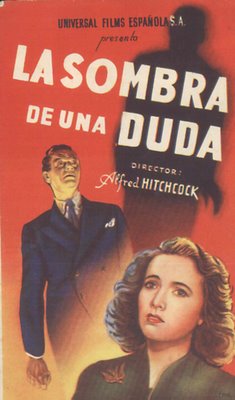
Honestly, you have to feel a little sorry for the publicity department at Universal this time. Just how do we sell this Shadow Of A Doubt anyway? I know --- shadows! We’ll put em’ everywhere! So what if people become disoriented in a theatre lobby tricked out with floor level lighting and patron’s shadows projected twenty feet high on the opposite wall. No less problematic was the idea of putting actors in store windows and having them stage various acts of mayhem for passerbys. Would the performers be obliged to repeat the same gag ad nauseum throughout the evening and into the night? Do bear in mind that all this took place years before Hitchcock took an active role in the selling of his movies. He’d have never permitted stunts as lame as these. By the 1950’s, he’d apply the same creativity with publicity campaigns that he brought to bear on the films themselves. Ever see the Psycho trailer? Hitchcock personally supervised the roll-out for everything with his name on it. He could have retired from directing at any time and successfully taken over the publicity department of any studio in town, and probably done a better job than any one hundred flacks in residence there. Fortunately for Universal, the innate qualities of Shadow Of A Doubt allowed it to succeed despite the efforts of their sales division.
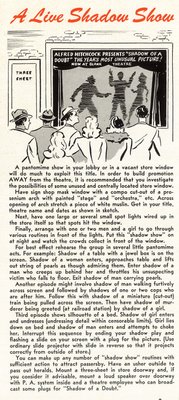
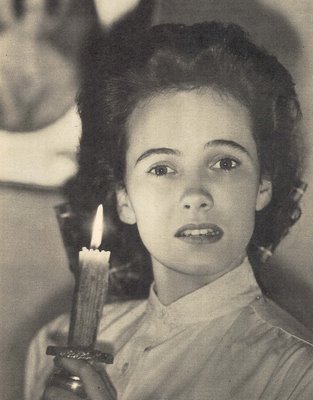
My good friend Lou Sabini met Teresa Wright quite by chance one day about four years ago. He’d been teaching a film class in Stamford, Connecticut when one of his students mentioned that she was next-door neighbors with Teresa. The lady told Lou that Miss Wright (then in her eighties) favored a bright blue baseball cap, which she always wore when she went out. He made a mental note of that and went on with the class, which coincidentally, included a showing of Shadow Of A Doubt. A few months later, Lou was at his job with Sleep, Etc., a furniture store in Norwalk, CT., when an elderly woman entered the store to look at some beds. When he approached her to lend an assist, Lou recognized Teresa Wright immediately. Sure enough, she was wearing the baseball cap, but she also had that crooked eyebrow he remembered from all her movies. This was the real tip-off (see the photo of Teresa with the candle… and the eyebrow). After a moment or two of conversation, she introduced herself as "Teresa", and Lou responded with "Yes, I know, Teresa Wright." According to him, she was taken aback, but pleased to learn he was a film collector and teacher. They ended up talking awhile, and Lou says she was great. Just think, one minute you’re selling furniture on a slow day, and the next you’re hanging out with one of your all-time favorite actresses --- the star of The Best Years Of Our Lives, Pursued, The Little Foxes, Shadow Of A Doubt … well, that’s some kinda thrill, we think. Thanks Lou, for a great memory!

 Roscoe Arbuckle's Birthday Nobody got a rawer deal than Roscoe Arbuckle (3/24), but that’s not news. He’s one silent star you can mention among civilians (you know, those non-film fanatics we have to share the planet with), and a surprising number of them know all about him. Or they think they do. Usually, you get Oh yeah, he killed the girl during that orgy, or an indelicate reference to Coke bottles. Well, we know better. So did that third jury when they came out and said the State Of California owed Roscoe a very big apology. Well, how do you give a man his life back after dragging him through a mess like this? They started out accusing him of capital murder, for Cripe’s sake! Some say Arbuckle’s films were allowed to deteriorate over the years because nobody wanted to be reminded of him. They pretty nearly accomplished that, because a lot of them are gone now. Roscoe himself had a vault hidden somewhere, but nobody’s been able to locate it. I wish they could. His reputation could still use some major rehab. As a comedian he’s not up there with Chaplin or Keaton, but maybe we’d all appreciate him a little more if the prints looked better. Whenever I read about that fateful Labor Day weekend in 1921, I think about how close Roscoe came to staying home, then I think if only he had, and all that other stuff we can’t do anything about now. His accusers were a scruffy lot. Blackmailers, abortionist doctors, crooked prosecutors, you name it. Poor Roscoe (notice I don’t call him Fatty --- he never liked that) dropped $700,000 in legal fees (this is 1921 money!) and still got banished from the screen despite his courtroom vindication. The dead woman, Virginia Rappe, was said to have had five abortions by the time she was sixteen, and an out-of-wedlock child when she was seventeen. Wacky Mack Sennett had her tossed off the Keystone lot for spreading venereal disease, though it was later revealed she had lice! Boy, the stuff that went on in those tumultuous teens --- lice --- ugh. So you can see what Roscoe was up against. It’s nice to know he had a comeback of sorts just before the end. Warner Bros. hired him for a series of Vitaphone shorts in 1932. He did six. I’ve seen most of them, and they’re good. A couple of them, Hey, Pop! and Buzzin’ Around, are really good. This was the best exposure Roscoe had since the trial. Warners was talking up more for him, maybe even features. All that collapsed when he died unexpectedly of a heart attack in his hotel room in 1933. He was only forty-six. Good friend Buster Keaton said he died of a broken heart. I don’t know as I agree, although the damage had been done and it was devastating. Still, things were looking up for Roscoe. On that final evening out, he and his wife had dinner with Ed Sullivan, of all people. Is it any wonder Ed was so blasé about The Beatles thirty years later? After all, he’d once dined with the Arbuckles!
Roscoe Arbuckle's Birthday Nobody got a rawer deal than Roscoe Arbuckle (3/24), but that’s not news. He’s one silent star you can mention among civilians (you know, those non-film fanatics we have to share the planet with), and a surprising number of them know all about him. Or they think they do. Usually, you get Oh yeah, he killed the girl during that orgy, or an indelicate reference to Coke bottles. Well, we know better. So did that third jury when they came out and said the State Of California owed Roscoe a very big apology. Well, how do you give a man his life back after dragging him through a mess like this? They started out accusing him of capital murder, for Cripe’s sake! Some say Arbuckle’s films were allowed to deteriorate over the years because nobody wanted to be reminded of him. They pretty nearly accomplished that, because a lot of them are gone now. Roscoe himself had a vault hidden somewhere, but nobody’s been able to locate it. I wish they could. His reputation could still use some major rehab. As a comedian he’s not up there with Chaplin or Keaton, but maybe we’d all appreciate him a little more if the prints looked better. Whenever I read about that fateful Labor Day weekend in 1921, I think about how close Roscoe came to staying home, then I think if only he had, and all that other stuff we can’t do anything about now. His accusers were a scruffy lot. Blackmailers, abortionist doctors, crooked prosecutors, you name it. Poor Roscoe (notice I don’t call him Fatty --- he never liked that) dropped $700,000 in legal fees (this is 1921 money!) and still got banished from the screen despite his courtroom vindication. The dead woman, Virginia Rappe, was said to have had five abortions by the time she was sixteen, and an out-of-wedlock child when she was seventeen. Wacky Mack Sennett had her tossed off the Keystone lot for spreading venereal disease, though it was later revealed she had lice! Boy, the stuff that went on in those tumultuous teens --- lice --- ugh. So you can see what Roscoe was up against. It’s nice to know he had a comeback of sorts just before the end. Warner Bros. hired him for a series of Vitaphone shorts in 1932. He did six. I’ve seen most of them, and they’re good. A couple of them, Hey, Pop! and Buzzin’ Around, are really good. This was the best exposure Roscoe had since the trial. Warners was talking up more for him, maybe even features. All that collapsed when he died unexpectedly of a heart attack in his hotel room in 1933. He was only forty-six. Good friend Buster Keaton said he died of a broken heart. I don’t know as I agree, although the damage had been done and it was devastating. Still, things were looking up for Roscoe. On that final evening out, he and his wife had dinner with Ed Sullivan, of all people. Is it any wonder Ed was so blasé about The Beatles thirty years later? After all, he’d once dined with the Arbuckles!
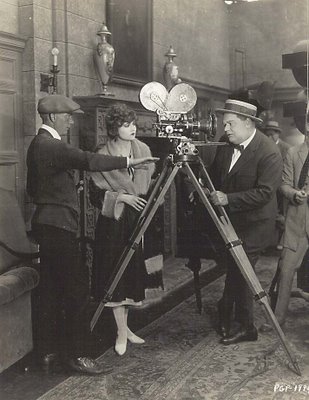
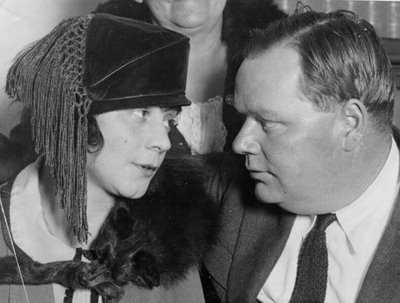

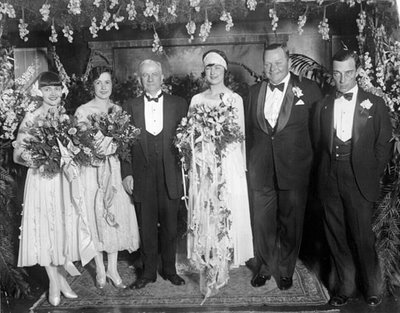
Stars who are good to their doggies always rate special mention at the Greenbriar, as I'm devoted to my pooch as well (even if he was sprayed by a skunk last night). This portrait is actually dated 1924, well after Roscoe’s retreat behind the cameras. He might have been seeking a director spot around this time, or perhaps a return to the stage. In any case, that sobered expression reveals a changed man. From happier days, here is Roscoe at Paramount doing close inspection on the camera lens for This Is So Sudden, a title which must have been changed (or the picture abandoned?). We do know his Paramount features were shelved and/or withdrawn after the trial. I assume that’s director George Melford serenading Roscoe and crew during The Round-Up in 1920, but by all means, correct me if I'm wrong. From the trial --- two dramatic shots. Roscoe in the courtroom --- and his stunned, disbelieving countenance tells the whole story, as if the horror of this ordeal were still not fully absorbed. Former wife Minta Durfee provides a courtroom lifeline in a revealing close look at the two --- she was there throughout to provide moral support. Roscoe seems to be regarding the last friend he has left in the world. Maybe he was. Finally, his wedding three years later to Doris Deane on May 17, 1925. The best man is stalwart pal Buster Keaton, and that’s Natalie second from the left. Buster kept a framed portrait of Roscoe on his wall till the day he died.
 Monday Glamour Starter --- Natalie Wood --- Part 1Some of us neighborhood boys were gathered in a tree house around 1963 when one of our number began to brag about having seen Gypsy the previous day. Yeah, man, it’s about this stripper, and Natalie Wood is totally naked through the whole thing! Now that was a pretty incendiary claim for anyone to have tossed about in that year, and we were more a bit skeptical. Now wait a minute, did you say totally naked? Like she showed everything? Absolutely, he swore. Well, I wasn’t buying that tall-tale any more than the one I’d heard from a kid at school describing a scene in Black Zoo where it showed a lion biting a man’s head off. But we’re here to talk about Natalie Wood, not Michael Gough. For a lot of people, Natalie Wood as an actress made Crawford look like Sarah Bernhardt, but whether or not Natalie could act was never the point. She was a product --- the movieland equivalent of those exciting new frozen TV dinners being offered for the first time in the mid-fifties. She was the glorious last stand for that dying era when the studios could make the public believe anything. From the beginning, they knew it was just the kids who’d buy her. This was the Confidential era. Stars were being outed on any number of accounts --- be it past criminal records (Rory Calhoun), alleged promiscuity (Maureen O’Hara – she sued), or that favored stand-by, the closeted homosexual. This last one was the net that closed around several of Nat’s co-stars and "boyfriends", and it was considered the most damning. Teenagers didn’t generally read the peek-a-boo rags, though. They were more Dad’s speed, something to go with cocktails and ribald conversation during Happy Hour. Besides, Natalie had real integrity. She was a teen just like them, save for the Thunderbird, the pool, and the ermine jacket (even fan mags liked to have a little fun with their readers). As for her own reading, Nat was said to favor Dostoevski and Nietzsche. She and Nick Adams used to read Thomas Wolfe together. Is it any wonder they came terribly close to getting married? Her soulful side was duly celebrated in the fan press, though sometimes they went far afield, as in Nat’s confession that she carried a snapshot of James Dean’s headstone in her wallet. That one had to give parents the willies, but the Dean death cult was a popular avalanche that simply could not be banked, and all the young stars enjoyed mild flirtations with it, particularly those ambitious young players trying to get ahead at Warner Bros. Some of them went to extremes --- Nick Adams, Dennis Hopper, etc. For all I know, Hopper’s still trying to channel Jimmy’s spirit, for all the Dean-prattling he still makes with during interviews (could this be why he’s so credible in all those latter-day psychotic villain parts?). There’s nothing quite so gooey and ghoulish as Natalie and others grave-worshipping Dean in all those post-9-30-55 fan profiles. All of her dates for a while were would-be Dean reincarnations, from swarthy thrift-shop "rebel" Scott Marlowe (he of several AIP J.D. cheapies) to poor lifelong star sycophant Nick Adams with his customized hot rod patterned after Jim’s wheels. For herself, Natalie didn’t want to be tarred with a "rebel" brush. Indeed, she was an apostle of clean living --- Why drink? If I drink, I’m bound to feel bad, and I won’t be able to work the next day. If I don’t work, I’ll be unhappy --- and look at the money I’ll lose for the studio, not to say myself. Indeed, Natalie preferred sodas. So did the parents of her young readers. The same parents who gave their children an allowance to buy movie magazines and go see Natalie Wood pics. Everybody understood the rules, you see, and abided by them. It’s true they wouldn’t much longer, but Natalie was there and at the top while they still did --- riding the last glorious wave of a culture that would soon disappear. I wonder if she realized it?
Monday Glamour Starter --- Natalie Wood --- Part 1Some of us neighborhood boys were gathered in a tree house around 1963 when one of our number began to brag about having seen Gypsy the previous day. Yeah, man, it’s about this stripper, and Natalie Wood is totally naked through the whole thing! Now that was a pretty incendiary claim for anyone to have tossed about in that year, and we were more a bit skeptical. Now wait a minute, did you say totally naked? Like she showed everything? Absolutely, he swore. Well, I wasn’t buying that tall-tale any more than the one I’d heard from a kid at school describing a scene in Black Zoo where it showed a lion biting a man’s head off. But we’re here to talk about Natalie Wood, not Michael Gough. For a lot of people, Natalie Wood as an actress made Crawford look like Sarah Bernhardt, but whether or not Natalie could act was never the point. She was a product --- the movieland equivalent of those exciting new frozen TV dinners being offered for the first time in the mid-fifties. She was the glorious last stand for that dying era when the studios could make the public believe anything. From the beginning, they knew it was just the kids who’d buy her. This was the Confidential era. Stars were being outed on any number of accounts --- be it past criminal records (Rory Calhoun), alleged promiscuity (Maureen O’Hara – she sued), or that favored stand-by, the closeted homosexual. This last one was the net that closed around several of Nat’s co-stars and "boyfriends", and it was considered the most damning. Teenagers didn’t generally read the peek-a-boo rags, though. They were more Dad’s speed, something to go with cocktails and ribald conversation during Happy Hour. Besides, Natalie had real integrity. She was a teen just like them, save for the Thunderbird, the pool, and the ermine jacket (even fan mags liked to have a little fun with their readers). As for her own reading, Nat was said to favor Dostoevski and Nietzsche. She and Nick Adams used to read Thomas Wolfe together. Is it any wonder they came terribly close to getting married? Her soulful side was duly celebrated in the fan press, though sometimes they went far afield, as in Nat’s confession that she carried a snapshot of James Dean’s headstone in her wallet. That one had to give parents the willies, but the Dean death cult was a popular avalanche that simply could not be banked, and all the young stars enjoyed mild flirtations with it, particularly those ambitious young players trying to get ahead at Warner Bros. Some of them went to extremes --- Nick Adams, Dennis Hopper, etc. For all I know, Hopper’s still trying to channel Jimmy’s spirit, for all the Dean-prattling he still makes with during interviews (could this be why he’s so credible in all those latter-day psychotic villain parts?). There’s nothing quite so gooey and ghoulish as Natalie and others grave-worshipping Dean in all those post-9-30-55 fan profiles. All of her dates for a while were would-be Dean reincarnations, from swarthy thrift-shop "rebel" Scott Marlowe (he of several AIP J.D. cheapies) to poor lifelong star sycophant Nick Adams with his customized hot rod patterned after Jim’s wheels. For herself, Natalie didn’t want to be tarred with a "rebel" brush. Indeed, she was an apostle of clean living --- Why drink? If I drink, I’m bound to feel bad, and I won’t be able to work the next day. If I don’t work, I’ll be unhappy --- and look at the money I’ll lose for the studio, not to say myself. Indeed, Natalie preferred sodas. So did the parents of her young readers. The same parents who gave their children an allowance to buy movie magazines and go see Natalie Wood pics. Everybody understood the rules, you see, and abided by them. It’s true they wouldn’t much longer, but Natalie was there and at the top while they still did --- riding the last glorious wave of a culture that would soon disappear. I wonder if she realized it?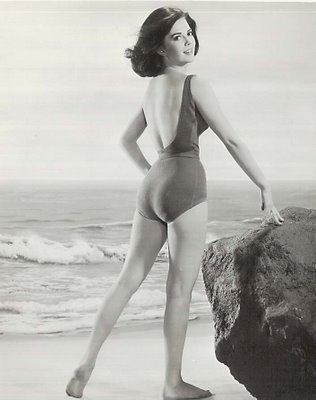
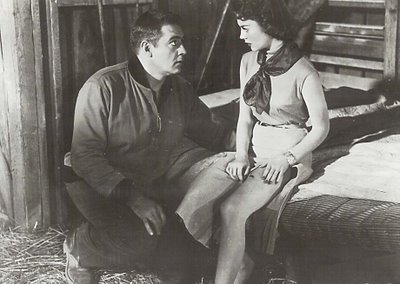 Based on what we know now, Natalie’s "romances" take on an almost surrealistic quality. Check out her dance card for 1956-57 --- Tab Hunter, Sal Mineo, Raymond Burr (gulp!) --- the list goes on. Safe dates all, and after a traumatic sexual assault that was alleged to have taken place when Natalie was just fifteen, you can understand her reasoning. Tab’s excellent new autobio goes into their on and off-screen partnership. While he and Nat were photographed endlessly on studio manufactured "dates", Tab says he was shacked up with Tony Perkins, something Natalie presumably knew all about. Well, she and Tab were both Warner contractees, and useful to each other, as well as to the studio, so it was a comfortable arrangement, as long as fans bought the lie (which they did, in droves). Tab went on to say that he and Scott Marlowe were an item before Marlowe took up with Natalie in an affair that she seems to have taken somewhat seriously. Well, who says Brokeback Mountain’s a new idea? The notion of pairing Nat with Sal Mineo was downright cracked, however. Even the dumbest kid in the auditorium had to be hep to Sal, but again, he was caught up in the same studio net as she, and each was comforted by the other’s skill at playing the game. For me, Raymond Burr’s the joker in the deck. Now where’d he come from? Well, as it turns out, they’d done a little picture together called A Cry In The Night, where Ray was convincing, as always (what a great actor!), in the part of a psycho Mamma’s Boy who kidnaps Natalie (this was before WB knew best how to exploit her). She and Ray hit it off, or so it was alleged by the breathless fan corps --- "he opened up new worlds of culture to her" (what, that again?). We were assured that nothing serious would happen with Tab (I’ll say it wouldn’t) because "her real heart is Raymond Burr" (you’ll have to forgive some of that prose, folks, cause it ain’t like these mags had Thomas Wolfe on their editorial staffs). Ray, or his publicists, had already dreamed up a cockamamie story involving at least three previous marriages (one of the wives supposedly went down in Leslie Howard’s doomed plane!) and even a son that no one had actually seen, so Ray was no stranger to showbiz subterfuge. "Once there was an understanding for the future with Raymond Burr", they all gushed, but one can only hope that Natalie never bought into that. As for these fan magazines, I can’t really recommend them to modern readers. Having just examined a brace of them, my brain feels like a bowl of oatmeal that’s been left on the breakfast table too long.
Based on what we know now, Natalie’s "romances" take on an almost surrealistic quality. Check out her dance card for 1956-57 --- Tab Hunter, Sal Mineo, Raymond Burr (gulp!) --- the list goes on. Safe dates all, and after a traumatic sexual assault that was alleged to have taken place when Natalie was just fifteen, you can understand her reasoning. Tab’s excellent new autobio goes into their on and off-screen partnership. While he and Nat were photographed endlessly on studio manufactured "dates", Tab says he was shacked up with Tony Perkins, something Natalie presumably knew all about. Well, she and Tab were both Warner contractees, and useful to each other, as well as to the studio, so it was a comfortable arrangement, as long as fans bought the lie (which they did, in droves). Tab went on to say that he and Scott Marlowe were an item before Marlowe took up with Natalie in an affair that she seems to have taken somewhat seriously. Well, who says Brokeback Mountain’s a new idea? The notion of pairing Nat with Sal Mineo was downright cracked, however. Even the dumbest kid in the auditorium had to be hep to Sal, but again, he was caught up in the same studio net as she, and each was comforted by the other’s skill at playing the game. For me, Raymond Burr’s the joker in the deck. Now where’d he come from? Well, as it turns out, they’d done a little picture together called A Cry In The Night, where Ray was convincing, as always (what a great actor!), in the part of a psycho Mamma’s Boy who kidnaps Natalie (this was before WB knew best how to exploit her). She and Ray hit it off, or so it was alleged by the breathless fan corps --- "he opened up new worlds of culture to her" (what, that again?). We were assured that nothing serious would happen with Tab (I’ll say it wouldn’t) because "her real heart is Raymond Burr" (you’ll have to forgive some of that prose, folks, cause it ain’t like these mags had Thomas Wolfe on their editorial staffs). Ray, or his publicists, had already dreamed up a cockamamie story involving at least three previous marriages (one of the wives supposedly went down in Leslie Howard’s doomed plane!) and even a son that no one had actually seen, so Ray was no stranger to showbiz subterfuge. "Once there was an understanding for the future with Raymond Burr", they all gushed, but one can only hope that Natalie never bought into that. As for these fan magazines, I can’t really recommend them to modern readers. Having just examined a brace of them, my brain feels like a bowl of oatmeal that’s been left on the breakfast table too long. 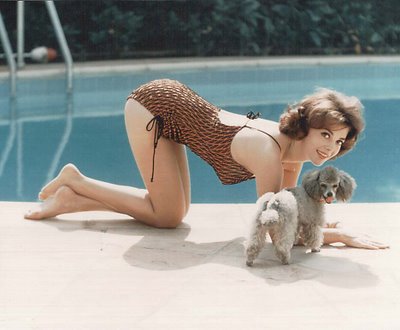
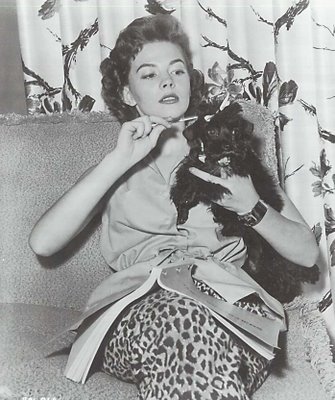
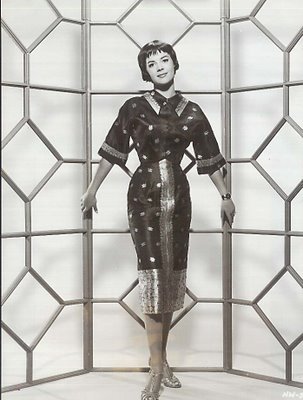 These Warner publicity stills require little explanation, other than to point out the script in Natalie’s lap (it’s resting on that rather alarming leopard skin she appears to be wearing). Close examination reveals that it’s for The Searchers. Wonder if Natalie made any margin notes? Perhaps a few suggestions for Mr.Ford as to how he might improve his movie…. You’ll note too that Natalie’s a little fickle about her dogs. Were they both hers, or was one discarded in favor of the other? "From Betty Higgins’ shop in the swank Royal Hawaiian Hotel came this exotic cocktail gown of a rare silk and gold metallic material imported from India." That’s the caption for this fashion tie-in on The Girl He Left Behind (1956), which goes on to say, "Natalie’s off-screen wardrobe roused the envy and admiration of her co-workers in her current Warner Bros. production."
These Warner publicity stills require little explanation, other than to point out the script in Natalie’s lap (it’s resting on that rather alarming leopard skin she appears to be wearing). Close examination reveals that it’s for The Searchers. Wonder if Natalie made any margin notes? Perhaps a few suggestions for Mr.Ford as to how he might improve his movie…. You’ll note too that Natalie’s a little fickle about her dogs. Were they both hers, or was one discarded in favor of the other? "From Betty Higgins’ shop in the swank Royal Hawaiian Hotel came this exotic cocktail gown of a rare silk and gold metallic material imported from India." That’s the caption for this fashion tie-in on The Girl He Left Behind (1956), which goes on to say, "Natalie’s off-screen wardrobe roused the envy and admiration of her co-workers in her current Warner Bros. production."

 Hoppy and The Blue BirdsOne of these days, I’m going to post one of these old stills, and someone’s going to comment or e-mail with "That’s me!" or maybe, "That’s MOM!" I wish it could happen today, for here is Hoppy with two sets of Blue Birds, representing candy mint drives for 1950 and 1951. The goal was to "extend the Camp Fire Girls program to more girls in the Los Angeles area". The red, white, and navy blue uniforms signified the junior organization of Campfire Girls, known as Blue Birds. So there, now you know. All that’s left to do now is find these girls! The ones at the radio station are identified as, left to right, Martha Warn, Joan Stabler, and Patricia Van Hartesfeldt --- according to the caption, they "wanted Hoppy to have the first sample". Folks, I don’t care what’s gone on in these girl's lives since 1951 --- they’ve got to remember this day. The other photo, with Hoppy in costume, finds him with twin sisters Johanna and Karen Lindquist. Wonder if any of them have copies of these stills. Are the Campfire Girls still a going concern? Do they still sell candy mints? One of you out in L.A. should know. Check it out, or better yet, find those girls!
Hoppy and The Blue BirdsOne of these days, I’m going to post one of these old stills, and someone’s going to comment or e-mail with "That’s me!" or maybe, "That’s MOM!" I wish it could happen today, for here is Hoppy with two sets of Blue Birds, representing candy mint drives for 1950 and 1951. The goal was to "extend the Camp Fire Girls program to more girls in the Los Angeles area". The red, white, and navy blue uniforms signified the junior organization of Campfire Girls, known as Blue Birds. So there, now you know. All that’s left to do now is find these girls! The ones at the radio station are identified as, left to right, Martha Warn, Joan Stabler, and Patricia Van Hartesfeldt --- according to the caption, they "wanted Hoppy to have the first sample". Folks, I don’t care what’s gone on in these girl's lives since 1951 --- they’ve got to remember this day. The other photo, with Hoppy in costume, finds him with twin sisters Johanna and Karen Lindquist. Wonder if any of them have copies of these stills. Are the Campfire Girls still a going concern? Do they still sell candy mints? One of you out in L.A. should know. Check it out, or better yet, find those girls!
The Choice Of Wake Forest Collegiates?G.F. Ann has a brother who went to Wake Forest University (then College) during the mid-sixties. A few weeks ago, she borrowed one of his old yearbooks for some reason, and I was flipping through it when I saw this. Now, under ordinary circumstances, I wouldn’t share what most would consider a commonplace relic of long-past schooldaze, but, well --- just look at that 4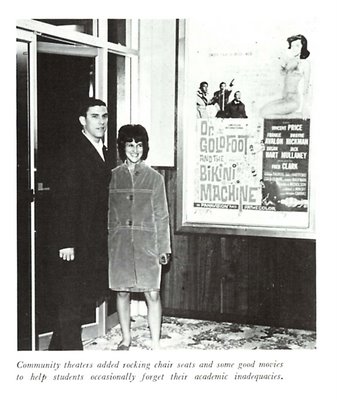 0X60 poster behind those two students. Dr.Goldfoot and The Bikini Machine! Our best and brightest going to see an American-International picture!! Couldn’t they have located a display that might better reflect their academic status and discriminating tastes? A Man For All Seasons must have been playing somewhere. Better to stand in the rain beneath a drive-in marquee featuring Blow-Up and Who's Afraid Of Virginia Woolf? than submit to such indignity as this. You’d think these kids would have considered their futures. What if the selection committee at that medical school got a squint at such a compromising pose? It was OK for an eleven-year old like me to go see Dr.Goldfoot (and I did, too!), but I never dreamed a near grown-up would sit for dross of that sort. But who am I to talk, as I just watched it again a few months ago, and good news, folks, it still holds up! Maybe these two weren’t so misguided after all.
0X60 poster behind those two students. Dr.Goldfoot and The Bikini Machine! Our best and brightest going to see an American-International picture!! Couldn’t they have located a display that might better reflect their academic status and discriminating tastes? A Man For All Seasons must have been playing somewhere. Better to stand in the rain beneath a drive-in marquee featuring Blow-Up and Who's Afraid Of Virginia Woolf? than submit to such indignity as this. You’d think these kids would have considered their futures. What if the selection committee at that medical school got a squint at such a compromising pose? It was OK for an eleven-year old like me to go see Dr.Goldfoot (and I did, too!), but I never dreamed a near grown-up would sit for dross of that sort. But who am I to talk, as I just watched it again a few months ago, and good news, folks, it still holds up! Maybe these two weren’t so misguided after all.


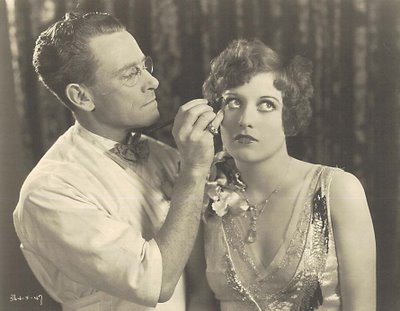
 Joan Crawford's Birthday
Joan Crawford's Birthday
Joan Crawford (3/23) may not be anyone’s idea of a great actress, but she could sure do melodrama, a thing people stood hip-deep in line for back in her day. Nobody slapped or got slapped as much as she did. Poor David Brian walked around for weeks with Joan’s handprint on his cheek (and from what we hear, her clawmarks on his back), while Ann Blyth gave her a whopping that almost flipped Joan over the stair bannister in Mildred Pierce. Second-string slapees included John Garfield, Steve Cochran, Van Heflin … even portly Sydney Greenstreet got ambushed in his rocking chair during a fierce exchange in Flamingo Road. Confrontations were Joan’s bag. She liked them on the set, and at home as well. Second husband Franchot Tone got into the act when he gave her a pasting over some disagreement, which was a switch from milder-mannered Doug Fairbanks Jr., who was said to have demurred whenever Joan tied on the gloves. Is it any wonder this woman lost all contact with reality? The story goes that she blew her entire fee from one of those TV show appearances in the late sixties by treating the crew to a full-tilt Crawford entrance on Day One of shooting --- cheuffered limousine, baskets of food and drink for everybody --- the works. She might as well have been paying Universal for the job. By close of that first day, she knew every man on the crew --- and his wife, and kids, and whatever else it took to get ingraitiated and thereby insure their protection in the event she needed it. A kind of genius, that’s what she was. If current actresses had half her survival skills, maybe they’d last beyond those three or four years which seem to about be the run of the play for distaff players among us nowadays. Joan was no spoiled child of privilege. They had her cleaning toilets in those Dickensian orphanages from early girlhood, and damned if she didn’t carry the habit right into the star days, obsessively cleaning toilets in every Beverly Hills mansion she visited before she’d sit on them. Yipes! Well, they say you never get over those childhood traumas, and Joan evidently needed steamer trunks to tote hers around. Pity she couldn’t enjoy the stardom more, because she had it longer than just about any femme name I can think of. Billing above the title from the twenties into the seventies --- amazing. At least three or four separate re-inventions --- flapper, shopgirl, fashion plate, post-war noir leads, horror hag ---hey, that’s five! Have I missed some? And all that stuff about the daughter --- I mean, who cares now? It’s not like they’re ever going to release her in a DVD box set, and how many more years is she going to whine anyway? Have she and the Bette Davis daughter ever taken their show on the road together? That might be good showmanship at least, though it’s been decades since their books, and I guess there’s only so much water in a well. I read that Crawford spent her last days in seclusion, with only a devoted fan to wait upon her. He/She (which?) slept on the floor at the foot of Joan’s bed --- just like a faithful dog. Really gothic, methinks, though I wish Joan could have lived longer to enjoy the attentions of serious film historians and interviewers. On those occasions when she did sit for career reflections, Crawford was very lucid and informative. Too bad she didn’t leave more of those insights behind.
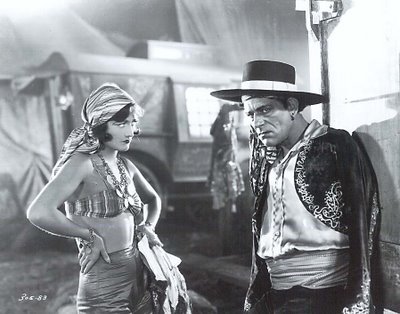
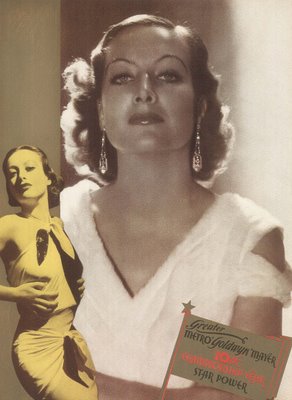
 Above: Indefatigable working actress Joan sits for make-up on her breakthrough pic, Our Dancing Daughters. Exhibitors did back-flips for this one as their houses brimmed over with jazz-mad teens and would-be flappers. Joan’s ambition ran at fever pitch. She even wanted to cut short her honeymoon with Doug Jr. so she could return home to the lot. Corporate employers would love her today. Maybe it was the siren call of all that fan mail that lured her back, and folks, she personally answered every single letter on the back of that truck! Joan tried to rise above humble beginnings by slavishly observing every social nicety. She’d send a gift, the recipient would reply with a thank-you note, then Joan would respond with a thank-you note for the thank-you note! For all we know, she was still thanking for thanking for thanking in 1977 for gifts she’d sent out in 1927. Death may well have been her only release from that bondage. It’s doubtful that crusty old Lon Sr. (what am I saying? He was only in his mid- forties when he made The Unknown!) would have been that impressed with Joan’s etiquette, but according to her, he was some kind of great acting teacher. Many years after this shot was taken in 1927, when Joan was pulling time at Universal doing a Virginian episode, she was approached by a knowing crew member and fan who asked her what it was like to work with Lon. To the fan’s delight, she was most complimentary of Chaney, and happy to reminisce. If they'd only filmed those casual on-set conversations instead of yet another dreary installment of that bloated hoss-opry.
Above: Indefatigable working actress Joan sits for make-up on her breakthrough pic, Our Dancing Daughters. Exhibitors did back-flips for this one as their houses brimmed over with jazz-mad teens and would-be flappers. Joan’s ambition ran at fever pitch. She even wanted to cut short her honeymoon with Doug Jr. so she could return home to the lot. Corporate employers would love her today. Maybe it was the siren call of all that fan mail that lured her back, and folks, she personally answered every single letter on the back of that truck! Joan tried to rise above humble beginnings by slavishly observing every social nicety. She’d send a gift, the recipient would reply with a thank-you note, then Joan would respond with a thank-you note for the thank-you note! For all we know, she was still thanking for thanking for thanking in 1977 for gifts she’d sent out in 1927. Death may well have been her only release from that bondage. It’s doubtful that crusty old Lon Sr. (what am I saying? He was only in his mid- forties when he made The Unknown!) would have been that impressed with Joan’s etiquette, but according to her, he was some kind of great acting teacher. Many years after this shot was taken in 1927, when Joan was pulling time at Universal doing a Virginian episode, she was approached by a knowing crew member and fan who asked her what it was like to work with Lon. To the fan’s delight, she was most complimentary of Chaney, and happy to reminisce. If they'd only filmed those casual on-set conversations instead of yet another dreary installment of that bloated hoss-opry.

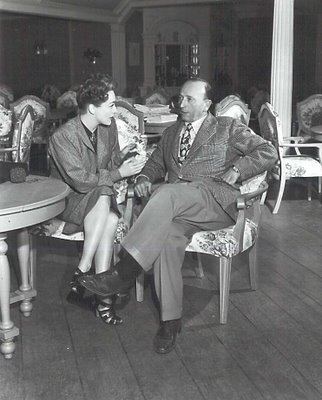
Here’s Joan and Constance Bennett at one of those vaguely unsettling Hollywood parties where everyone dressed up like little kids. Charlie Chaplin no doubt knocked off early on City Lights so he could be there. By the looks of Joan and Connie, this would seem to be his kind of bash, but did anyone really need to be confronted with Irving Thalberg in a sailor suit with a whistle in his mouth? (yes, there's a still of that from the same party, but I'm holding it for another day). Speaking of kids, check out the caption on this next one --- "JOAN CRAWFORD ADDS HER NAME TO THE AUTOGRAPH BOOKS OF OUR GANG YOUNGSTERS … Darla and Alfalfa, appearing in their first feature-length production, "The Ice Follies Of 1939", in which Miss Crawford is starred." First off, I think this is totally bogus. Alfalfa probably wanted Crawford’s autograph about like he wanted castor oil, and where are any Our Gangers in Ice Follies Of 1939? I’ve never sat through this feature, and had no idea Darla and Alfalfa were among the cast. Otherwise, I might have tuned in (I assume their footage was excised prior to release). Anybody know the story on this? Finally, an on-set "huddle" (that’s what the caption said) between Joan and martinet director Mike Curtiz during Mildred Pierce. Did he really rip off her trademark shoulder pads and berate her in front of the crew on the first day of shooting? Well, it was worth it if he did, cause this picture revived an all but dormant career, and gave Crawford another decade’s momentum before the next lull.
 Monday Glamour Starter --- Natalie Wood --- Part 2
Monday Glamour Starter --- Natalie Wood --- Part 2


 Natalie drops in on Warner Brothers Presents host Gig Young at the "location" for The Searchers as they pose before one of the most audacious process screens ever to stand in for an outdoor setting. Natalie speaks to the home viewers as though she were giving the valedictorian address at Hollywood High School. These "behind-the-scenes" moments were forced on ABC by Warners as part of the deal when that studio finally agreed to dip its corporate toes into video waters. The program collapsed in the first season. The photo offering we next see was part of the campaign for The Girl He Left Behind, a peacetime service romance in which Natalie and Tab Hunter were teamed for the first time. Selling fan photos in bulk meant exhibitors could hand them out to patrons coming in, or use them as giveaways with radio dee-jays, record stores, and the like. Director David Butler later confessed that he’d have preferred young supporting player James Garner for the lead instead of Hunter, but the big guns were behind Tab after Battle Cry, so Garner was vetoed by studio brass. Butler also recalled Natalie having to take breaks for school "lessons" and avoid exhaustion (still a minor, you see). Trouble is, as soon as work was finished, she’d be off for all-night partying, and come in the next day --- exhausted. Must have been an excess of ice-cream sodas, as we’re assured by the fan mags that Natalie was a model teen.
Natalie drops in on Warner Brothers Presents host Gig Young at the "location" for The Searchers as they pose before one of the most audacious process screens ever to stand in for an outdoor setting. Natalie speaks to the home viewers as though she were giving the valedictorian address at Hollywood High School. These "behind-the-scenes" moments were forced on ABC by Warners as part of the deal when that studio finally agreed to dip its corporate toes into video waters. The program collapsed in the first season. The photo offering we next see was part of the campaign for The Girl He Left Behind, a peacetime service romance in which Natalie and Tab Hunter were teamed for the first time. Selling fan photos in bulk meant exhibitors could hand them out to patrons coming in, or use them as giveaways with radio dee-jays, record stores, and the like. Director David Butler later confessed that he’d have preferred young supporting player James Garner for the lead instead of Hunter, but the big guns were behind Tab after Battle Cry, so Garner was vetoed by studio brass. Butler also recalled Natalie having to take breaks for school "lessons" and avoid exhaustion (still a minor, you see). Trouble is, as soon as work was finished, she’d be off for all-night partying, and come in the next day --- exhausted. Must have been an excess of ice-cream sodas, as we’re assured by the fan mags that Natalie was a model teen.














































